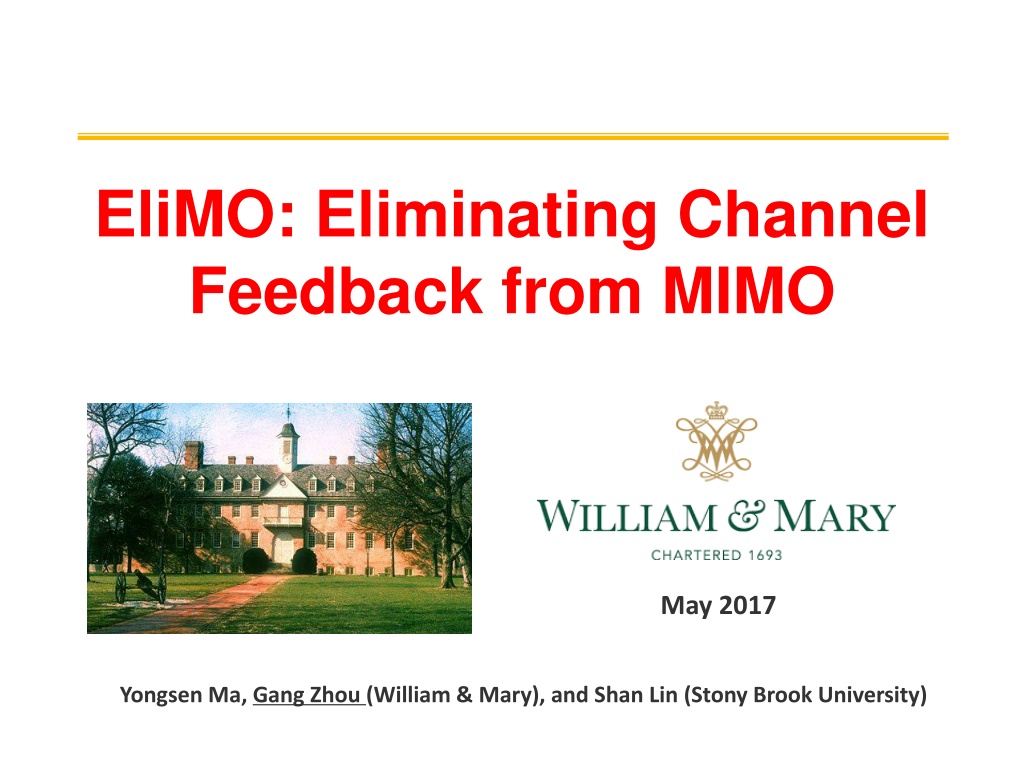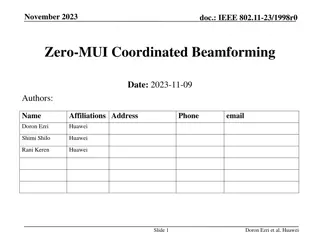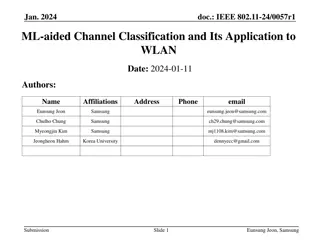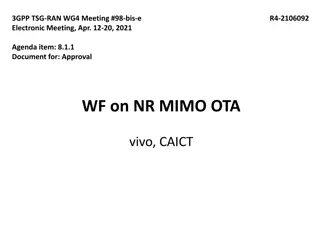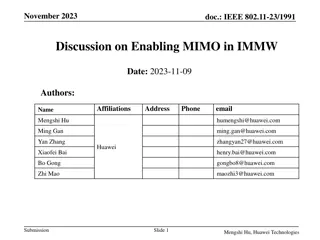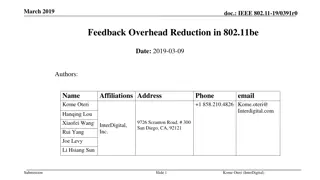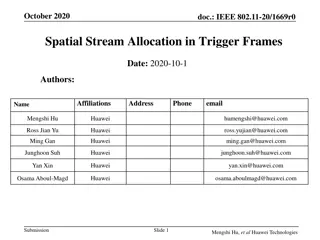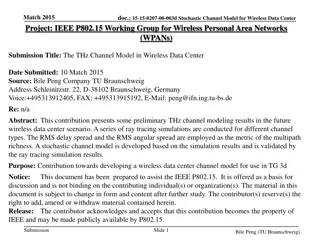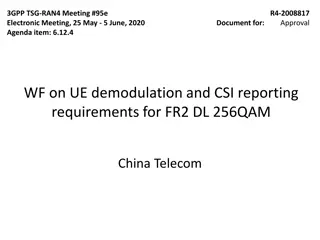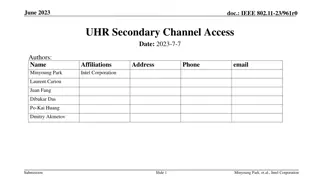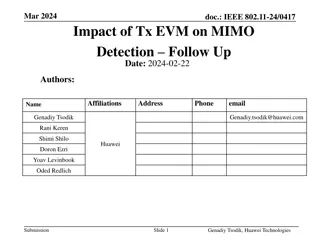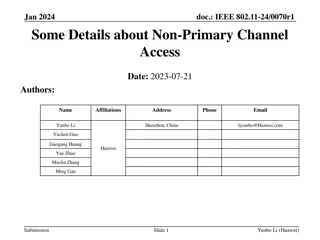EliMO: Eliminating Channel Feedback from MIMO
This study explores the elimination of explicit CSI feedback in MIMO systems for WiFi beamforming to achieve high throughput. It introduces EliMO, a two-way CSI estimation protocol, comparing it with implicit and explicit feedback methods. The research focuses on downlink and uplink CSI estimation techniques, reducing computational and communication overhead. By analyzing the effectiveness of CSI elimination and two-way estimation, the study aims to improve SNR without explicit feedback while maintaining low overhead.
Download Presentation

Please find below an Image/Link to download the presentation.
The content on the website is provided AS IS for your information and personal use only. It may not be sold, licensed, or shared on other websites without obtaining consent from the author.If you encounter any issues during the download, it is possible that the publisher has removed the file from their server.
You are allowed to download the files provided on this website for personal or commercial use, subject to the condition that they are used lawfully. All files are the property of their respective owners.
The content on the website is provided AS IS for your information and personal use only. It may not be sold, licensed, or shared on other websites without obtaining consent from the author.
E N D
Presentation Transcript
EliMO: Eliminating Channel Feedback from MIMO May 2017 Yongsen Ma, Gang Zhou (William & Mary), and Shan Lin (Stony Brook University)
MIMO Needs CSI Feedback MIMO beamforming provides high throughput for WiFi Image from www.broadbandbuyer.com Image from www.howtogeek.com To achieve high beamforming performance, feedback of Channel State Information (CSI) is needed. Implicit or Explicit CSI Feedback William & Mary 2
Implicit CSI Feedback AP measures ACK s LTF from STA to get uplink CSI AP uses the transpose of uplink CSI as downlink CSI Downlink CSI (Hd) and uplink CSI (Hu) are not reciprocal, leading to low SNR. d and u: over-the-air channels Hd and Hu: baseband-to-baseband channels At, Ar, Bt, & Br: digital baseband channels William & Mary 3
Explicit CSI Feedback STA measures NDP s LTF to get downlink CSI STA sends measured downlink CSI to AP Measuring and transmitting CSI introduce high computation & communication overhead William & Mary 4
Eliminating CSI Feedback Can we completely eliminate explicit CSI feedback? And achieve as high SNR as explicit CSI feedback With as low overhead as implicit CSI feedback ELIMO: two-way CSI estimation for WiFi AP estimates downlink CSI without explicit CSI feedback STA does not send CSI to AP William & Mary 5
Outline Introduction EliMO Two-way CSI Estimation EliMO Protocol Design Evaluation Conclusions William & Mary 6
Two-way CSI Estimation LTF(X) Data Yu Yf LTF Data AP Hd Hu STA Receive, amplify, & transmit LTF(X) FTF ACK time Two-way CSI HtwEstimation: Htw =MMSE(X,Yf) Downlink CSI HdEstimation: Htw = HuHd Uplink CSI Hu Estimation: Hu = MMSE(X,Yu) Hd = (Hu)+Htw William & Mary 7
Block Diagram STA only needs to amplify and send FTF to AP No need for STA to measure downlink CSI: reduced computation No need for STA to send CSI to AP: reduced communication William & Mary 8
Outline Introduction EliMO Two-way CSI Estimation EliMO Protocol Design Evaluation Conclusions William & Mary 9
Packet Format Implementing two-way CSI estimation in 802.11n/ac FTF: Feedback Training Field, received signals of LTF FTR: Feedback Training Request/Response 802.11n mixed mode packet 802.11ac packet William & Mary 10
MAC Operation AP sends LTF and FTR to STA STA puts received LTF, amplify it, and put it in FTF STA sends LTF, FTR, and FTF to AP AP computes downlink CSI Hd, which is used for sending the next data packet William & Mary 11
Dealing with Stale CSI Downlink CSI could be stale: t1 + t2 is too large AP sends NDP (w/ FTR) to request STA to measure downlink CSI, when either similarity of two recent CSI measurements is smaller than 0.98 or the time from the previous ACK ( t2) is larger than 100ms William & Mary 12
Outline Introduction EliMO Two-way CSI Estimation EliMO Protocol Design Evaluation Conclusions William & Mary 13
Evaluation Setup AP & STA are laptops with Intel WiFi Link 5300 installed The power signal of WiFi chipset can not be programed to amplify and transmit in slide 7. So we use trace-driven simulation. Downlink/uplink CSI traces (Hd & Hu) Frequency: 5GHz; channel width: 20MHz AP: 3 external antennas; STA: 3 internal antennas Transmitting power: 17/15dBm for the AP/STA Scenarios Static: both AP and STA are static Mobile: the STA is randomly moving (~1.2m/s); the AP is static William & Mary 14
Evaluation: SNR & Overhead tcontrol/(tcontrol+tdata) EliMO achieves as high SNR as explicit CSI feedback, with as low overhead as implicit CSI feedback William & Mary 15
Evaluation: Throughput When static, EliMO s throughput is 5X/4X/1.7X of Implicit , Explicit per 1pkt", and Explicit per 10pkts". Explicit per 10pkt means one explicit CSI feedback for every 10 data packets When mobile, these numbers are 3.6X/4.5X/1.4X William & Mary 16
Evaluation: Energy When static, EliMO's energy consumption is 85%/30%/50% of that of Implicit , Explicit per 1pkt", and Explicit per 10pkts". When mobile, these numbers are 90%/17%/57% William & Mary 17
Related Work Compressed CSI feedback, but still need CSI feedback The same CSI for multiple packets, subcarriers, and/or antennae. [MobiCom 13] Less bits to represent CSI [MobiCom 13] Less frequent CSI feedback [CoNEXT 14] No CSI feedback Echo-MIMO [IEEE TOSP 08] is similar to us, but not compatible with WiFi. Narrow-band channels without frequency-selective effects Over-the-air channels, not digital baseband channels Pure theoretical analysis, not in a WiFi compatible protocol, not tested with real devices William & Mary 18
Conclusions EliMO uses two-way CSI estimation and Feedback Training Field to accurately estimate downlink CSI without explicit CSI feedback. EliMO is WiFi compatible. EliMO significantly reduces computation, communication, and energy overhead for WiFi receivers. Thank You! This work has been supported by NSF CNS-1253506 (CAREER) and CNS-1553272 (CAREER). William & Mary 19
